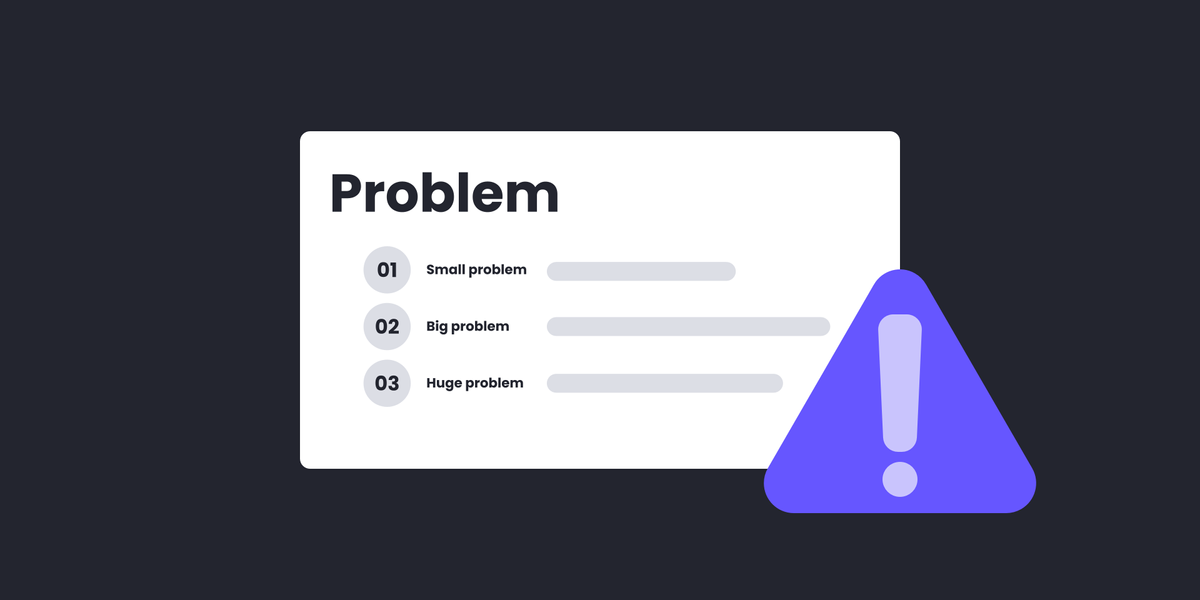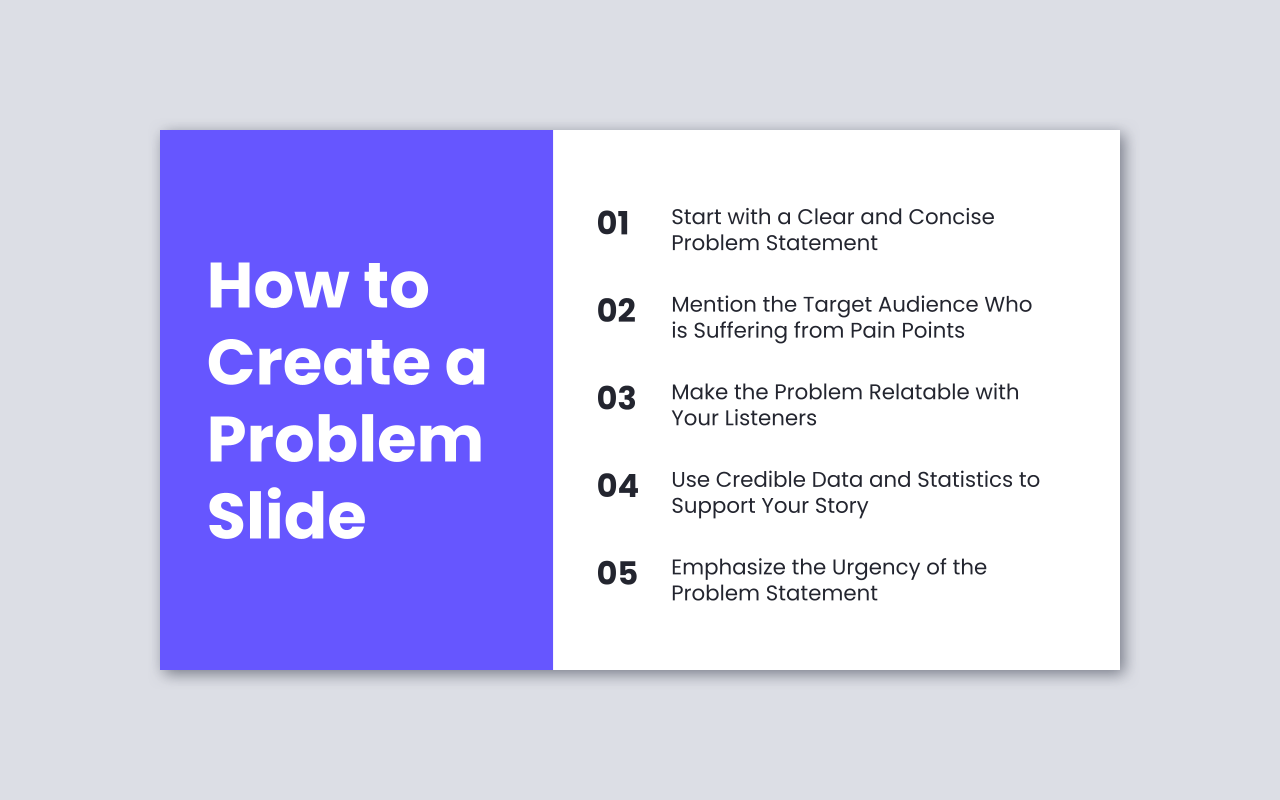How to Create a Problem Slide for Your Pitch Deck
A problem slide outlines the pain points your startup addresses, highlighting its significance and impact. Learn to create an effective one today!

Ever wondered why some startup pitches instantly grab attention while others fail? The secret often lies in how well they present their problem slide. But what exactly is a problem slide? Think of it as the opening scene of your startup story.
A problem slide is an important part of your pitch deck that highlights a specific pain point. It’s your opportunity to show that you’ve recognized a significant market need worth addressing. Let’s explore why this slide is essential and how to create one that grabs investors' attention.
Why is the Problem Slide Important
Your problem slide is the foundation of your entire pitch. Just like a strong base is essential for a house, a solid problem slide supports everything else in your presentation. A well-made problem slide serves two critical goals:
- It creates context for your solution, helping investors understand why your startup needs to exist
- It demonstrates your deep understanding of the market and your target audience's pain points
When done well, your problem slide can connect emotionally with your audience in the first few minutes of your presentation. This connection is crucial for keeping investors engaged throughout your pitch.

How to Create a Problem Slide
Start with a Clear and Concise Problem Statement
Your problem statement should be crystal clear and immediately understandable. Imagine explaining your startup's problem to a friend over coffee – keep it simple, direct, and jargon-free.
Mention the Target Audience Who is Suffering from Pain Points
Be specific about who experiences this problem. Instead of saying "people need better transportation," say "urban commuters spend an average of 2 hours daily stuck in traffic." This specificity helps investors visualize your target market.
Make the Problem Relatable with Your Listeners
Share real-life examples that your audience can relate to. For instance, if you're pitching a productivity app, talk about the frustration of using multiple tools for simple tasks - something many professionals face every day.
Use Credible Data and Statistics to Support Your Story
Back up your claims with compelling numbers. For instance: "73% of remote workers struggle with collaboration tools, leading to 5.3 hours of lost productivity per week." Remember, specific numbers are more credible than general statements.
Emphasize the Urgency of the Problem Statement
Help your audience understand why this problem needs solving now. Highlight new trends, changes in the market, or rising user demands that show why your solution is needed now. By explaining how these factors create an urgent need, you can clearly communicate on your pitch deck that why it's important to take action immediately.
"The basic parts is your problem should be pretty big, pretty pervasive, have a lot of these characteristics to make it feel like there's a very big market that a lot people have the problem." as Kevin Hale once said in Y Combinator's Startup School. Focusing on big, pervasive problems ensures your solution addresses a large market, maximizing potential impact and success.
Mistakes to Avoid
Overstuffing Data
One common pitfall is cramming too much information onto your problem slide. For example, don't list ten different statistics about market size, user behavior, and industry trends all at once. Instead, focus on the most impactful data point that supports your problem statement.
Bad example: A slide showing 15 different charts about email marketing challenges.
Good example: A single, clear statistic: "91% of marketing professionals waste 3+ hours daily managing email campaigns manually."
Generic Problem Case
Avoid vague problem statements that could fit any industry or situation. Instead, be clear and specific about the particular challenge you are tackling. This helps your audience understand exactly what issue you’re addressing and why it matters.
Bad example: "People want better healthcare."
Good example: "Rural patients wait an average of 19 days to see a specialist, leading to delayed treatments and worse health outcomes."
No Valid Evidence to Back Your Assumptions
Don’t make claims without providing evidence to support them. Every important statement should be backed by reliable data or facts. This strengthens your argument and helps build trust with your audience.
Bad example: "Many people struggle with meal planning."
Good example: "According to a 2024 Food Industry Report, 67% of working parents spend over $200 monthly on unplanned takeout due to poor meal planning."
Frequently Asked Questions
How do I clearly define the problem on a pitch deck?
Focus on a single, urgent pain point, back it up with real market data, and make sure it's easy for an investor to grasp quickly even someone outside your industry should “get” it instantly.
What’s the investor looking for in a problem slide?
Investors want to see that you’ve identified a big, widespread problem with significant market opportunity. Connect the problem to a large market or urgent trend to frame the scale and relevance.
Can I use examples or stories on this slide?
Yes! Real-world examples, customer testimonials, or even case studies help make the problem relatable and memorable. Airbnb famously used clear lines and stats in their problem slide.
The Short of It
Mastering how to create a problem slide for your pitch deck is the first step to making your story stand out. When you clearly define the problem, you show investors that you understand your market and are ready to solve a real need. This matters because a strong problem slide can be the difference between getting noticed or being overlooked.
If you want to make your pitch even stronger, why not grab a free pitch deck template? It’s a simple way to get started and put these ideas into action. You’ve got this your next pitch deck could be the one that wins over investors.

Get a Professional Pitch Deck and Tell Compelling Stories
✓ Unique layouts ✓ Editable elements ✓ Free vector icons ✓ Compatible with Google Slides
Download now →